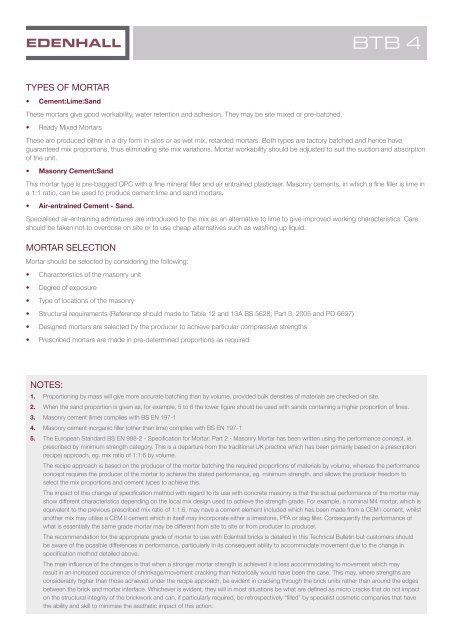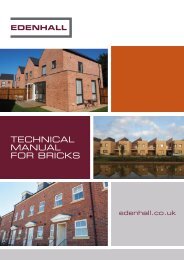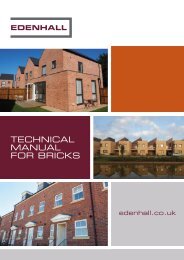Create successful ePaper yourself
Turn your PDF publications into a flip-book with our unique Google optimized e-Paper software.
BTB 4<br />
TYPES OF MORTAR<br />
• Cement:Lime:Sand<br />
These mortars give good workability, water retention and adhesion. They may be site mixed or pre-batched.<br />
• Ready Mixed Mortars<br />
These are produced either in a dry form in silos or as wet mix, retarded mortars. Both types are factory batched and hence have<br />
guaranteed mix proportions, thus eliminating site mix variations. Mortar workability should be adjusted to suit the suction and absorption<br />
of the unit.<br />
• Masonry Cement:Sand<br />
This mortar type is pre-bagged OPC with a fine mineral filler and air entrained plasticiser. Masonry cements, in which a fine filler is lime in<br />
a 1:1 ratio, can be used to produce cement:lime and sand mortars.<br />
• Air-entrained Cement - Sand.<br />
Specialised air-entraining admixtures are introduced to the mix as an alternative to lime to give improved working characteristics. Care<br />
should be taken not to overdose on site or to use cheap alternatives such as washing up liquid.<br />
MORTAR SELECTION<br />
Mortar should be selected by considering the following:<br />
• Characteristics of the masonry unit<br />
• Degree of exposure<br />
• Type of locations of the masonry<br />
• Structural requirements (Reference should made to Table 12 and 13A BS 5628; Part 3; 2005 and PD 6697)<br />
• Designed mortars are selected by the producer to achieve particular compressive strengths<br />
• Prescribed mortars are made in pre-determined proportions as required<br />
NOTES:<br />
1. Proportioning by mass will give more accurate batching than by volume, provided bulk densities of materials are checked on site.<br />
2. When the sand proportion is given as, for example, 5 to 6 the lower figure should be used with sands containing a higher proportion of fines.<br />
3. Masonry cement (lime) complies with BS EN 197-1<br />
4. Masonry cement inorganic filler (other than lime) complies with BS EN 197-1<br />
5. The European Standard BS EN 998-2 - Specification for Mortar: Part 2 - Masonry Mortar has been written using the performance concept, ie.<br />
prescribed by minimum strength category. This is a departure from the traditional UK practice which has been primarily based on a prescription<br />
(recipe) approach, eg. mix ratio of 1:1:6 by volume.<br />
The recipe approach is based on the producer of the mortar batching the required proportions of materials by volume, whereas the performance<br />
concept requires the producer of the mortar to achieve the stated performance, eg. minimum strength, and allows the producer freedom to<br />
select the mix proportions and cement types to achieve this.<br />
The impact of this change of specification method with regard to its use with concrete masonry is that the actual performance of the mortar may<br />
show different characteristics depending on the local mix design used to achieve the strength grade. For example, a nominal M4 mortar, which is<br />
equivalent to the previous prescribed mix ratio of 1:1:6, may have a cement element included which has been made from a CEM I cement, whilst<br />
another mix may utilise a CEM II cement which in itself may incorporate either a limestone, PFA or slag filler. Consequently the performance of<br />
what is essentially the same grade mortar may be different from site to site or from producer to producer.<br />
The recommendation for the appropriate grade of mortar to use with <strong>Edenhall</strong> bricks is detailed in this <strong>Technical</strong> Bulletin but customers should<br />
be aware of the possible differences in performance, particularly in its consequent ability to accommodate movement due to the change in<br />
specification method detailed above.<br />
The main influence of the changes is that when a stronger mortar strength is achieved it is less accommodating to movement which may<br />
result in an increased occurrence of shrinkage/movement cracking than historically would have been the case. This may, where strengths are<br />
considerably higher than those achieved under the recipe approach, be evident in cracking through the brick units rather than around the edges<br />
between the brick and mortar interface. Whichever is evident, they will in most situations be what are defined as micro cracks that do not impact<br />
on the structural integrity of the brickwork and can, if particularly required, be retrospectively “filled” by specialist cosmetic companies that have<br />
the ability and skill to minimise the aesthetic impact of this action.







